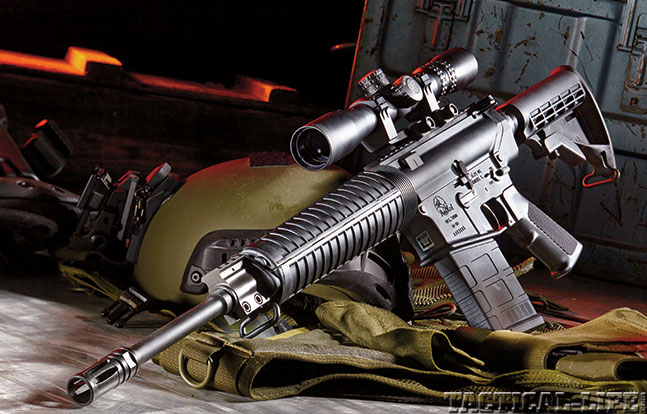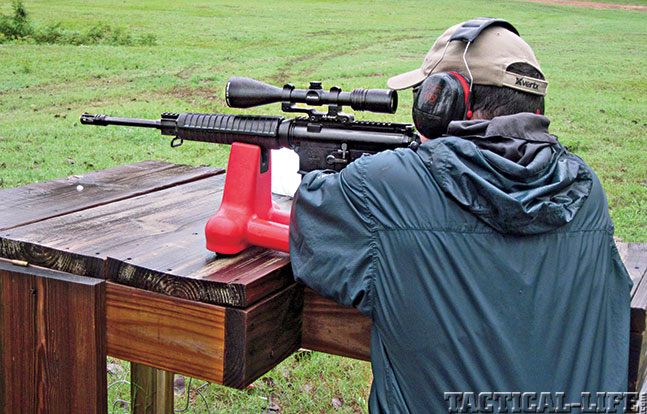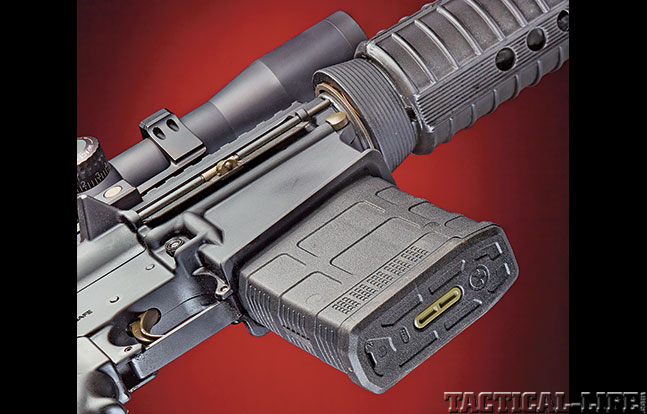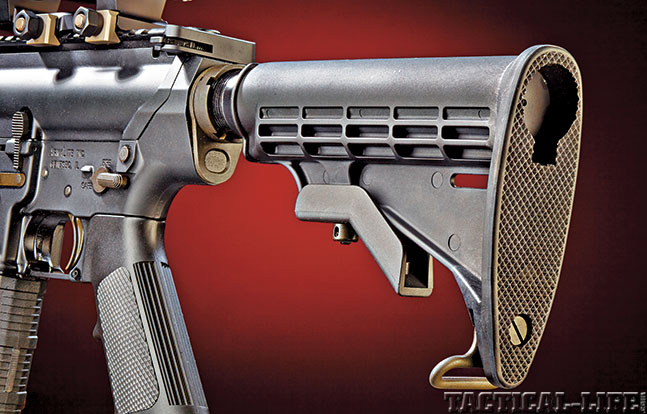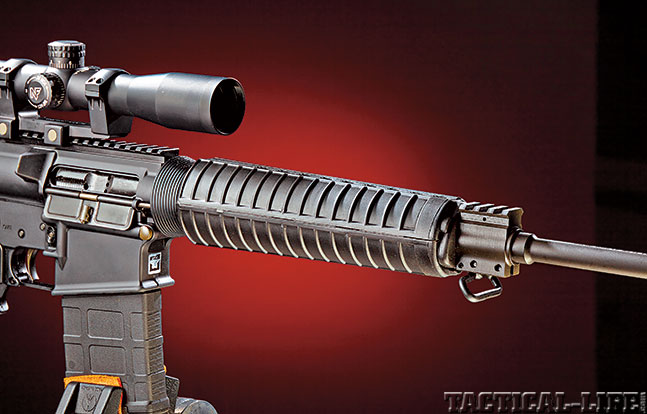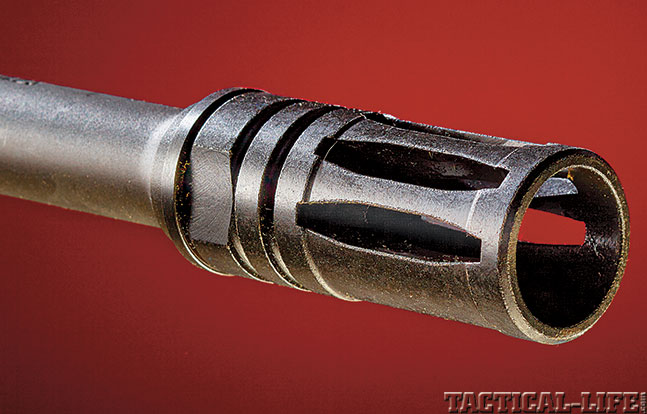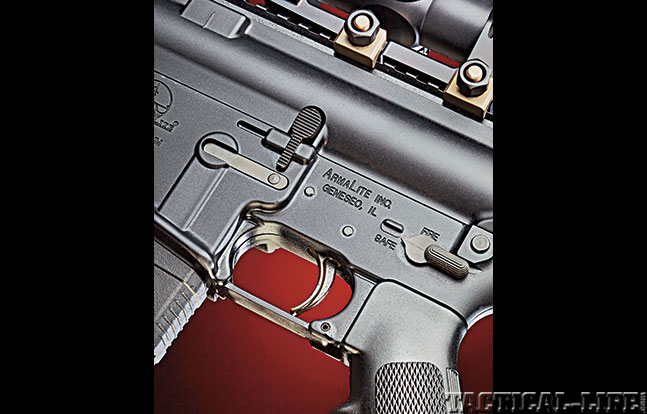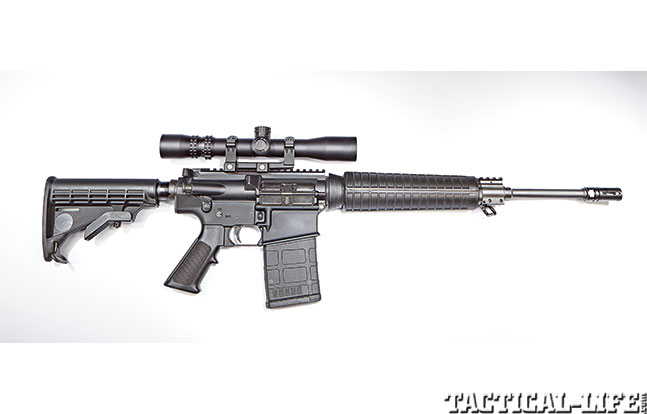ArmaLite literally put the “AR” in AR-15. Many people don’t realize that Eugene Stoner was working for ArmaLite when he developed the rifle. They also don’t realize that “AR” stands for ArmaLite Rifle. The company literally invented the rifle, and everything after it has simply been a copy. Also, Mr. Stoner originally intended for the rifle to be chambered in 7.62mm NATO/.308 Winchester. Putting my hands on the ArmaLite Defensive Sporting Rifle (DSR) 10 felt a little like going back to the beginning and embracing the future, all at the same time.
- RELATED: Gun Review: Armalite’s M-15TBN 5.56mm
- RELATED: Armalite Defenders: Evolved, Modern-Day Rifles
I am constantly bombarded by fellow federal agents asking me the same question: “I want to buy an AR-style rifle. Which one should I buy?” They are looking at rifles that cost between $600 and $5,000 and want to know if a more expensive rifle will be worth it. With very few exceptions, I tell them it will not. A rifle that is absolutely reliable, is simple to maintain and can easily be upgraded is almost certainly their best investment. Most people do not need a rifle that has every bell and whistle. They won’t be landing on beaches with it in the arctic. They won’t be shooting 5,000 rounds through it every week. They won’t be sniping bad guys in hostile territory from 1,000 meters. Rifles that can do those things are really cool, but they are also really expensive. A rifle that handles the basics, and does them well, will be just as useful to them as the $5,000 custom gun.
ArmaLite recognizes this fact. The company recognizes that most cops have families and a limited income, but they put their lives are on the line. ArmaLite’s challenge was to build the best fight-stopping, dependable weapon for a reasonable price. Its answer was the Defensive Sporting Rifle series. This series includes two rifles chambered in 5.56mm NATO, the DSR 15 and the DSR 15F. The DSR 15F has a fixed, A-frame front sight, and the DSR 15 has no front sight but allows one to be added to the Picatinny rail on top of the gas block. The third and final rifle in the series is the DSR 10, chambered in 7.62mm, which I recently got my hands on for testing.
Advertisement — Continue Reading Below
Gun Details
The DSR 10 does not come with a lot of extra features. Instead, ArmaLite focuses on high-quality fundamentals. What impressed me the most was the barrel. Made from 4140 chrome-moly steel, the barrel is hand-lapped twice, the bore is chrome lined and the exterior is phosphated. Barrels are typically made by one of three different processes: button cutting, hammer forging and single-point cutting. Each technique has certain benefits and detriments. Each technique also leaves tool marks on the lands and grooves that affect accuracy. Lapping a barrel means using an abrasive compound and running it up and down the barrel to smooth out some of the rough edges. I have an MDS bore scope that I often use to check out the barrels of the test guns and barrels during cleaning. You cannot judge how accurate a barrel will be simply by how it looks, but when there are lots of chatter marks, gouges or pitting in the steel, you know you aren’t likely dealing with a tack driver. The barrel on the DSR 10 looked as smooth as my hand-lapped, single-cut barrel that I special ordered from Krieger Barrels a few years back. In fact, I don’t think I have ever seen a production barrel that looked so clean and smooth. I had high hopes for the range testing.
Advertisement — Continue Reading Below
“… the DSR 10 comes with a phenomenal barrel and top-of-the-line reliability right out of the box.”
After the barrel, the next most important features for accuracy are a free-floating forend and a good trigger. The DSR 10 has a standard M4-style forend with single heat shields, which certainly helps keep the costs down. Plus, it allows the end-user to decide which style of forend they want on the rifle and install it themselves. There are literally hundreds of styles today to choose from and what works best for me may not be the best for you.
The trigger is a standard mil-spec-style unit, but it was the crispest mil-spec trigger I have ever shot. It had a little creep, but not very much. However, it was stiff. My Lyman electronic trigger gauge measured the pull weight as being 10.94 pounds. This dependable trigger is excellent for most combat and law enforcement purposes; it will work just fine. If you want a better trigger, again, there are plenty of high-quality drop-in kits to choose from. I will offer one word of caution. Most adjustable triggers are meant for competition and precision shooting—not combat. If a screw backs out and a trigger fails during a match, it really stinks. If it backs out and your rifle turns into a club during a firefight, it may be the last error you ever make. If you replace the trigger, get a solid, dependable one.
Advertisement — Continue Reading Below
The M4-style collapsible stock will lock into six different length-of-pull positions and is installed on a mil-spec-diameter buffer tube. Again, this is the kind of little feature that I appreciate. Mil-spec tubes have a different diameter than commercial tubes and are stronger. They typically cost a little more to make, so many manufacturers opt for commercial-sized tubes because most consumers won’t know the difference. My one small complaint was that the castle nut was not staked in place. This probably would never cause a problem, and if it really bothered me, I could do it myself with a center punch and a hammer in three seconds.
The gas block, a clamp-on-style unit with a Picatinny rail on top for mounting an iron sight, appears very robust. The Picatinny rail on the gas block sits about 0.39 inches lower than the Picatinny rail on the upper receiver. If you want to install iron sights, you have to buy the right style so that they will co-witness. No sights of any kind are provided with the rifle. Again, this keeps costs down and allows the end-user to only pay for the sight that they actually want.
The DSR 10 has a standard A2-style pistol grip. The rifle also uses the DPMS/KAC style of magazines, which is the most common type, and it means that Magpul magazines will fit. ArmaLite ships the DSR 10 rifle with one polymer, 20-round Magpul PMAG.
Advertisement — Continue Reading Below
I picked the rifle up on a Friday, gave it a quick cleaning and liberally oiled the bolt and bolt carrier. AR rifles will shoot dirty, but they will not shoot dry. The majority of AR weapon failures that I have seen through the years have been caused by insufficient lubrication. The biggest difference internally between an ArmaLite AR-10 and an AR-15 is that ArmaLite puts a spring on the AR-10 firing pins instead of leaving them free-floating, as they are on AR-15s. As you’d expect, the bolt carrier group and firing pin are larger and heavier on the 7.62mm NATO rifle. When you load and charge an AR-15, the firing pin flies forward and leaves a little “dimple” on the back of the primer of the round that was just chambered. Because of the extra weight, the AR-10 firing pin could fly forward and detonate the primer. ArmaLite prevents this by adding the firing pin spring.
Range Time
Advertisement — Continue Reading Below
The following morning was overcast with steady rain. I headed to the Brazos River Sportsman’s Club in Fulshear, Texas, to test the DSR 10’s accuracy and run it through some shooting drills. Whenever you are shooting paper targets in the rain, a clear, 55-gallon trash bag placed over the top will keep the target from disintegrating and allow you to shoot just as well as on a sunny day.
I rough-sighted the carbine in at 25 yards and then dialed it in at 100. Apart from having to wipe the scope lenses, the rain had no effect on the rifle or my Oehler 35P chronograph. The barrel did not disappoint, and the accuracy was far better than I expect to see on a rifle of this type. Several of the five-shot groups were under an inch.
For tactical drills, I mounted a Steiner 1-5x24mm scope with an illuminated reticle. Most of the drills were inside of 25 yards. Despite the light weight of the gun, recoil was very controllable, and the rifle was quick and easy to manipulate through drills with multiple rounds and multiple targets. In the end, I was pretty muddy, but I had nothing but good things to say about the DSR 10. I have shot a lot of rifles that cost quite a bit more money and were not nearly as accurate or as dependable as this one.
Advertisement — Continue Reading Below
When I first started out in law enforcement, I was on a pretty tight budget. I had to carefully consider gun purchases beforehand, and I was always hoping to find a gun that outperformed its price tag. The ArmaLite DSR 10 is exactly what I was looking for. With an MSRP of $999, I would expect a lengthy break-in period and 100-yard groups that hovered around the 3- to 4-inch range. Instead, the DSR 10 comes with a phenomenal barrel and top-of-the-line reliability right out of the box. While it may not have a lot of extra features, it allows the end-user to upgrade it when and how they see fit. Honestly, for tactical purposes, the addition of sights and a light are really all that are required. The end product will perform at the same level as rifles that cost a lot more money, and I would not hesitate to trust my life to its rock-solid dependability.
For more information, visit armalite.com or call 800-336-0184.
